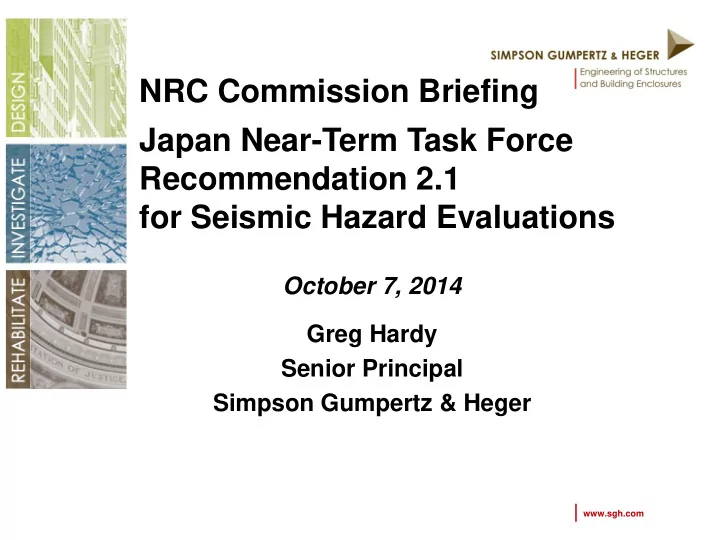

NRC Commission Briefing Japan Near-Term Task Force Recommendation 2.1 for Seismic Hazard Evaluations October 7, 2014 Greg Hardy Senior Principal Simpson Gumpertz & Heger www.sgh.com
2 Commission Requested Discussion Topic Improvements and Challenges Related to NTTF 2.1 Seismic • Improvements – Guidance Documents for 2.1 – Results from EPRI Research Tasks – Training for Industry and Regulators • Challenges – Aggressive Schedule – Limited Technical Expertise (Industry and NRC) – Changing Technical Environment vs. Regulatory Stability
3 Seismic Evaluation Guidance “SPID” EPRI Report 1025287, Seismic Evaluation Guidance: S creening, P rioritization and I mplementation D etails (SPID) February 2013 • Seismic Hazard Development • GMRS Comparisons • Screening • Prioritization (Schedule) • Seismic Risk Evaluation
Seismic Evaluation Guidance 4 Expedited Seismic Evaluation Program (ESEP) EPRI Report 3002000704, Seismic Evaluation Guidance • May 2013 1. Screening 2. Equipment Selection 3. Seismic Capacity Criteria 4. Modification Criteria
5 Research Innovations and Improvements • Methods developed for use of Finite Element and Lumped Mass Stick Models • High frequency testing • Seismic fragility based on earthquake and test experience data • State of the art seismic hazard development • Research on seismic capacity for deeply embedded bolts
Finite Element vs. 6 Lumped Mass Structure Models • Seismic Risk Assessments require Adequate Structure Models to develop Seismic Response Finite Element Model • Existing Nuclear Power Plants (NPPs) typically have lumped mass stick models (LMSM) • EPRI Report Late 2014 Lumped Mass Stick Model
High Frequency Program 7 152 Tests Conducted
HF Program Milestones and Remaining 8 Challenges • EPRI Test Summary Report – Issued Sept 15, 2014 • Majority of items are inherently rugged • SPRA Fragility guidance • In-structure and in-cabinet response • Complete application guidance to be reviewed by NRC prior to publishing
9 Training to Support NTTF 2.1 Seismic • Training to supports NTTF 2.1 Seismic – Technical Methods – Consistency in Submittals • Two Seismic hazard workshops (2013-2014) • HCLPF Training to Support Expedited Seismic Program • Seismic PRA Methodology Courses • Early SPRA Practitioners Workshops
Significant Progress Completed in Short Amount of Time …… but considerable challenges remain www.sgh.com 10
The Schedule for 2.1 Seismic Is Challenging ACTIVITIES Specific Specific rface Seismic Hazard rials GMRS Seismic Risk sment Frequency rmation Spent Fuel
12 Remaining Challenges • Detailed SPRAs require significant resources and schedules to complete • Technical methods still under discussion • Resulting seismic risk values are driven by very high uncertainties • Changes in key elements that drive seismic risk • Acceptable risk vs modifications vs development of more accurate seismic risk methods • Capabilities to Support SPRA Peer Reviews • Managing Periodic Updates of Hazard
Recommend
More recommend